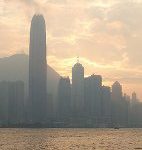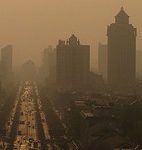Smog is becoming an ever more frequent feature of Guangzhou’s weather, and levels of particulate matter in the air are increasing too. As a result, more people are suffering the symptoms of respiratory diseases, which include shortness of breath, coughs, dizziness, weakness, nausea and even the loss of temper. But since the situation seemingly presents no immediate threat to life, it is easy to ignore.
But as the situation worsens, that may change. In early April the Southern Weekend newspaper carried a report about China’s worsening air pollution, which warned that London’s Great Smog may be repeated in Guangzhou. The Great Smog of December 1952 is famous as the world’s worst case of air pollution. In only five days more than 4,000 people in the British capital died from respiratory illnesses, many of them elderly people. In the following months a further 8,000 died. As early as the end of 2004, Tang Xiaoyan, a professor at the Peking University College of Environmental Science, made similar predictions based on his research: that a severe photochemical smog could arise in Guangzhou – or even across the entire Pearl River delta.
In fact, the air in the Pearl River delta has already been severely polluted by the manufacturing industry: air quality levels already fall to levels seen in London in 1952. The city of Shenzhen saw a record-breaking 226 days of smog in 2007. Smog is spreading across whole regions: in the urban areas around the Pearl River delta and around the whole Beijing and Tianjin metropolitan area. These cities are the main source of pollution and they also suffer from it the most. In 2006 only 4.3% of China’s 559 cities reached Class I air quality (the cleanest level), 58.1% averaged in Class II, 28.5% at Class III and the remaining 9.1% at even lower levels.
Almost every city in the Pearl River delta suffers from smog all year round. And as the provincial government attempts to shift the worst polluters out of the area, the problem only moves to the provinces of Jiangxi, Hunan and the northern part of Guangdong. I recently visited Qingxin, a county in central Guangzhou, which used to be renowned for its clean air, but now faces pollution from industries relocated from the Pearl River delta. Industrial output has been increasing every year, with many factories sprouting up in its still-expanding industrial zones. Economically, it has been a great success, but the damage to air quality is easy to see on your windscreen as the rain dries and leaves dirty grey marks.
Urban air pollution is a major threat to public health in China. Smog is made up of the soot and dust in the polluted air above our cities; it is a complex mix of hundreds of different types of particulate matter. Those most harmful to human health are tiny aerosol particles: minerals, salt, sulphates and nitrates that lodge in the lungs and breathing passages, giving rise to rhinitis and bronchitis – and cancer in the long term. Outdoor air pollution kills around 300,000 people in China every year, according to research in 2003 by Wang Jinnan, of the China Environmental Planning Institute. The country’s city dwellers have become like vacuum cleaners, each one of us filtering out the particulates from 15 cubic metres of air a day. The difference in air quality is striking to anyone who travels overseas.
Many are unaware of the risks and fail to connect their health problems with air pollution. But the public do not only suffer from the pollution, they also produce it. Surveys indicate that sources of urban air pollution are changing in the Pearl River delta; vehicle emissions are becoming the main culprit and may even exceed emissions from industry. In 2007 there were 1.8 million cars on Guangzhou’s roads and this number is growing by 150,000 every year. We are facing a gradual, yet potentially fatal, process that is reaching a tipping point: the conditions for air pollution to become very acute are already in place. Guangzhou’s unique climate has so far protected the city, but if things continue, a disaster is almost inevitable.
An environmental crisis is not like other emergencies. An isolated pollution accident or an explosion, for instance, occurs suddenly and can be dealt with quickly. An environmental crisis gathers form gradually on a large scale; once formed, it is hard to solve quickly. It is not a temporary problem, but something we have to live with every day. Therefore, we do not only need emergency measures, but also changes in our everyday life. We need laws that require local governments to control polluting industries, and measures to prevent air pollution in cities. Most importantly, we must find a way to alleviate a long-term crisis.
China’s government, businesses and people are not paying enough attention to the risks of a large-scale environmental disaster. When it is clear that polluters are not going to change their ways, the government should intervene. However, the gravity of the situation we face today can partly be blamed on government failures. For example, the very scale used to measure atmospheric pollution fails to reflect actual conditions. China’s environment authorities recognise a yearly average of 100 milligrams of particulate matter per cubic metre of air as a safe standard, five times the World Health Organization’s standard. They also do not measure particles over 2.5 nanometres in diameter, despite the fact they are the most toxic. There are huge differences between what the official data shows and what the public experiences. The law does not enforce environmental rulings and solve disputes as it should. Where in other countries the courts would handle environmental issues, in China the government takes control, which is far less efficient. The power of the public and civil society is weak; the right to be informed on environmental issues is not secure.
Of course, the system has also seen progress. For example, Guangzhou has been the first city to implement a smog forecasting system and many other cities are following suit. But scientists and the government must change China’s monitoring standards and make the results public. There are historical reasons for urban pollution in China’s cities, but we still have time to make a change and prevent chronic problems becoming an acute crisis. The clock is ticking.
Tang Hao is a newspaper columnist, deputy editor of Shimin (Citizen) magazine, and assistant professor of politics at Huanan Normal University. His essays and opinion pieces have appeared in Contemporary International Relations, International Studies, Nanfang Daily, Yangcheng Evening News, Southern Window and many other publications.
Homepage photo by 23hours



